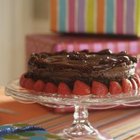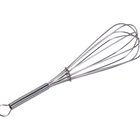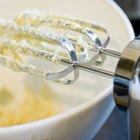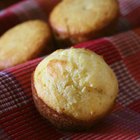
Flour is the backbone of your cake. It adds body, texture and is what holds everything together. But, flour can also be the worse enemy of your cake -- if it's over-mixed. Finding the right balance between incorporating your flour and not over-mixing it comes down to the type of flour and cake recipe you're using.
Flour's Purpose in Your Cake
Flour contributes to the structure and body of your cake, but it also adds flavor. Without flour, your ingredients would deflate and you would have a flat, dense cake. Within flour there is a protein, and when it's mixed with water and introduced to heat that protein it produces gluten, the material that adds strength and elasticity to your cake. Your recipe is likely to call for either all-purpose flour or cake flour, and the main difference between the two is their protein content. Cake flour contains 6 to 8 percent protein and is made from soft wheat flour, while all-purpose has a 10 to 12 percent protein content and is made from a blend of soft and hard wheat flours. Cake flour yields a velvety, smoother texture than all-purpose flour.
Mixing With the Alternating Method
Alternating methods have you add your dry ingredients to your butter-sugar mixture by alternating the dry with the liquid -- which is usually milk. Use the low speed setting on your mixer and add in a small amount of dry, following up with an equal amount of wet. Continue the process until all of the ingredients are added. Mix only until the ingredients are combined. You shouldn't see any flour or dry ingredients resting on top of the batter or on the sides of the bowl. The alternating method ensures flour is mixed thoroughly, but helps prevent you from over-mixing the batter.
Mixing With the Folding Method
Some recipes require you to fold whipped egg whites in with your butter, sugar and dry ingredients. Place the egg whites on top of the prepared batter. Use a large, flexible spatula and fold from the bottom up to the sides, slowly turn the bowl and repeat until everything is incorporated. Don't mix or stir. Small lumps of whipped egg whites in the batter is normal, but you should fold until you no longer see liquid cake batter pooling at the bottom of the bowl.
Signs You've Overmixed
If you've overmixed your ingredients, your baked cake might have a domed or cracked surface once it's done baking. Inside the cake you might notice tunnels, pits or holes, which is a sign that you produced too much gluten. Your cake may also be chewy and dense, similar to a bread. Although you cannot fix this once a cake batter is already prepared, you can reduce the amount of time you mix on the next batter to correct the issue.
Tips for Success
Before you mix your flour with the liquid or wet ingredients of your recipe, you should sift or gently whisk all dry ingredients together. This helps evenly distribute your dry ingredients once they're mixed into the wet -- and reduces the amount of time you must mix them together.
Related Articles

Does Hand Mixing Cakes Make Them More ...

What Kind of Flour to Use for Cupcakes?

How to Store Leftover Pancake Batter

How to Make Light Airy Italian Bread ...

What Are the Causes of Large Holes in a ...
Can Dry Pudding Be Added to Cake Mixes?

How to Make a Box Cake Firmer to Frost

How to Bake a Cake: A Step-By-Step Guide
Easy Banana Bread Recipe

Will Adding Cocoa Powder to a Cake Dry ...

How to Whisk Flour
Easy Italian Cream Cake Recipe

Does Baking Soda Affect the Height of a ...

What if You Forget to Put Eggs Into ...

How to Moisten Hard Frosting

Calories in a Large Corn Muffin
Easy White Cake Recipe
Should Cake Flour Be Sifted Before ...

What Causes Cupcakes to Fall?

What Are the Functions of Flour in ...
References
Writer Bio
Shailynn Krow began writing professionally in 2002. She has contributed articles on food, weddings, travel, human resources/management and parenting to numerous online and offline publications. Krow holds a Bachelor of Science in psychology from the University of California, Los Angeles and an Associate of Science in pastry arts from the International Culinary Institute of America.
Photo Credits
BananaStock/BananaStock/Getty Images